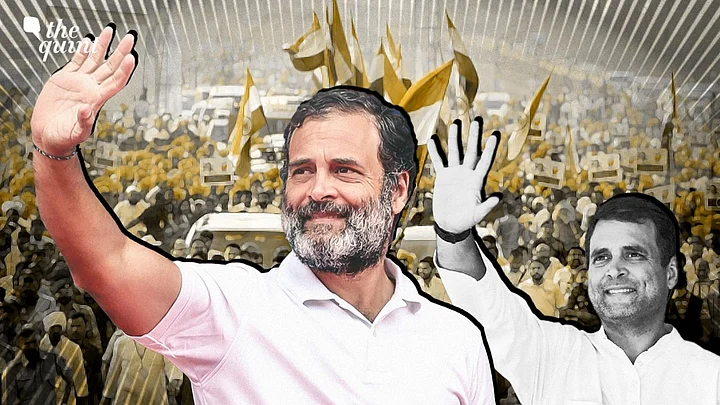How popular is Rahul Gandhi as a possible PM candidate? Can the former Congress president be an effective challenger to Prime Minister Narendra Modi?
The recent survey by NDTV and CSDS offers very interesting insights on these questions.
Read the first part of our analysis of the survey data focusing on PM Modi's popularity and the three threats he faces in the run-up to the 2024 Lok Sabha elections.
Now, coming back to Rahul Gandhi. There are a lot of positives that emerge from the survey for him but also some of the data that shows he still has a long way to go to be an effective challenger to the PM.
There are five key aspects that come out of this survey.
1. Rise in Rahul Gandhi's popularity
According to the NDTV-CSDS survey, 27 percent picked Rahul Gandhi as the PM candidate of their choice. This is an increase of four percentage points from the 2019 CSDS survey and 13 points from the 2014 survey.
This establishes Gandhi firmly as PM Modi's main challenger. The interesting part is that the major increase took place between 2014 and 2019. The increase since 2019 has been comparatively limited.
Though there is no data from CSDS on this, data from other surveys do suggest that there was a fall in Rahul Gandhi's popularity between 2019 and 2022, especially after the Lok Sabha defeat and his subsequent resignation as Congress president. Therefore it is possible that the increase between 2022 and 2023 may be sharper than the 2019 to 2023 figure.
2. Lower 'Dislike' Levels than PM Modi
It is significant that the percentage of respondents who said they 'dislike' Rahul Gandhi are lower than those who said they 'dislike' PM Modi. According to the survey, 23 percent respondents said they dislike PM Modi while 17 percent said they dislike Rahul Gandhi.
3. Bharat Jodo Yatra Impact
According to the survey, 26 percent respondents said they 'always liked Rahul Gandhi' while 15 percent said that they began liking him after the Bharat Jodo Yatra.
4. Congress' Rise Greater than Rahul Gandhi's Rise
In 2019, Rahul Gandhi's popularity was a bit higher than the Congress' vote share. According to 2019 CSDS post-poll survey, 23 percent wanted to see Gandhi as the PM while 19.5 percent said that they voted for the Congress.
It is possible that a number of respondents who may have wanted Rahul Gandhi as PM may still have voted for non-Congress parties possibly because a regional party may have been a more viable non-BJP choice. For instance, this could have been the case for many SP-BSP voters in Uttar Pradesh or Left voters in Kerala.
This pattern has changed now. In the 2023 CSDS survey, 27 percent respondents said they want Rahul Gandhi to be PM while 29 percent said they want to vote for the Congress. The increase in Gandhi's popularity has been four percentage points compared to 2019 but those picking Congress as their voting choice has increased by nearly 10 points compared to 2019.
During this period there has been no significant decline in the preference for BJP or PM Modi.
Therefore, the main change seems to have been non-BJP voters who may not have backed Congress for whatever reasons in 2019, are now actively considering voting for the party.
This increase in preference for the Congress could be due to the party showing its strength in state elections like Karnataka and Himachal Pradesh.
It is possible that the increase in Rahul Gandhi's popularity could partly be due to the rising consolidation behind the Congress in the non-BJP sphere.
5. Convincing Modi Voters Still a Task
According to the survey, when respondents were asked 'who is the main challenger to PM Modi?', 34 percent said Rahul Gandhi, 11 percent said Arvind Kejriwal, 5 percent said Akhilesh Yadav and 4 percent said Mamata Banerjee.
Now, this is a question in which Modi is naturally not an option so many Modi supporters get to choose from between Opposition leaders. Assuming that all the 27 percent who picked Rahul Gandhi as the PM choice also chose him in the challenger question, it means that the increase that Gandhi got by virtue of Modi not being a choice, is about 7 points. The increase for Kejriwal was also 7 points. Those saying 'others' or 'no one' increased by 7 and 9 points respectively.
This is a comparatively smaller number and indicates that Modi voters are probably not very enthusiastic about Rahul Gandhi even when Modi is not an option.
Not being able to get too many Modi voters to shift remains the main limitation for Rahul Gandhi and the Congress. The Congress has still managed to accomplish it at the state level, as is evident from the Himachal Pradesh and Karnataka results. But doing at the national level, still seems a challenge.
